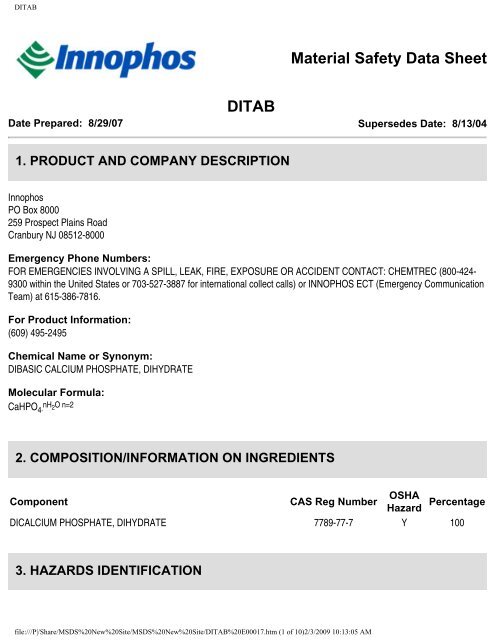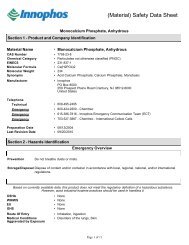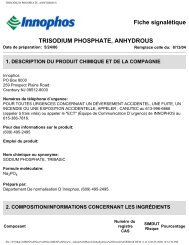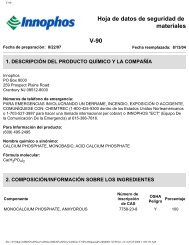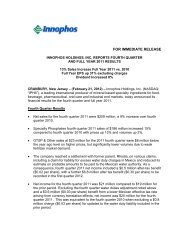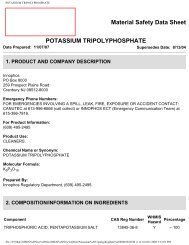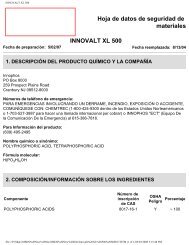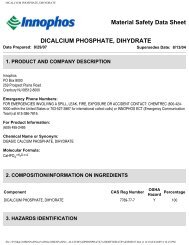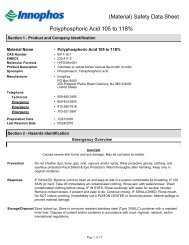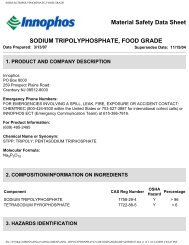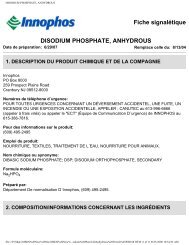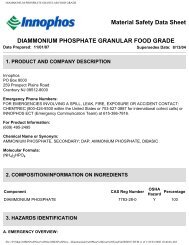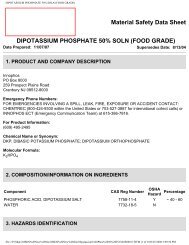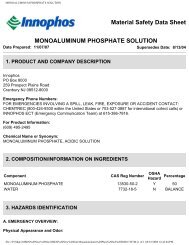Material Safety Data Sheet DITAB - Innophos
Material Safety Data Sheet DITAB - Innophos
Material Safety Data Sheet DITAB - Innophos
Create successful ePaper yourself
Turn your PDF publications into a flip-book with our unique Google optimized e-Paper software.
<strong>DITAB</strong><strong>Material</strong> <strong>Safety</strong> <strong>Data</strong> <strong>Sheet</strong><strong>DITAB</strong>Date Prepared: 8/29/07 Supersedes Date: 8/13/041. PRODUCT AND COMPANY DESCRIPTION<strong>Innophos</strong>PO Box 8000259 Prospect Plains RoadCranbury NJ 08512-8000Emergency Phone Numbers:FOR EMERGENCIES INVOLVING A SPILL, LEAK, FIRE, EXPOSURE OR ACCIDENT CONTACT: CHEMTREC (800-424-9300 within the United States or 703-527-3887 for international collect calls) or INNOPHOS ECT (Emergency CommunicationTeam) at 615-386-7816.For Product Information:(609) 495-2495Chemical Name or Synonym:DIBASIC CALCIUM PHOSPHATE, DIHYDRATEMolecular Formula:CaHPO 4 . nH 2 O n=22. COMPOSITION/INFORMATION ON INGREDIENTSOSHAComponentCAS Reg NumberHazard PercentageDICALCIUM PHOSPHATE, DIHYDRATE 7789-77-7 Y 1003. HAZARDS IDENTIFICATIONfile:///P|/Share/MSDS%20New%20Site/MSDS%20New%20Site/<strong>DITAB</strong>%20E00017.htm (1 of 10)2/3/2009 10:13:05 AM
<strong>DITAB</strong>Do not induce vomiting unless instructed to do so by a physician. No harmful affects expected. If appreciable quantities areswallowed, call a physician or poison control center. Do not leave victim unattended.MEDICAL CONDITIONS POSSIBLY AGGRAVATED BY EXPOSURE:Inhalation of product may aggravate existing chronic respiratory problems such as asthma, emphysema or bronchitis. Skincontact may aggravate existing skin disease.NOTES TO PHYSICIAN:All treatments should be based on observed signs and symptoms of distress in the patient. Consideration should be given tothe possibility that overexposure to materials other than this product may have occurred.Ingestion of large quantities of phosphate salts (over 1.0 grams for an adult) may cause an osmotic catharsis resulting indiarrhea and probable abdominal cramps. Larger doses such as 4-8 grams will almost certainly cause these effects ineveryone. In healthy individuals most of the ingested salt will be excreted in the feces with the diarrhea and, thus, not causeany systemic toxicity. Doses greater than 10 grams hypothetically may cause systemic toxicity. Treatment should take intoconsideration both anionic and cation portion of the molecule. The following treatments should be considered for the specificgroup(s) of phosphate salts found in this product:--All phosphate salts, except calcium salts, have a hypothetical risk of hypocalcemia, so calcium levels should be monitored.--Ammonium salts have a hypothetical risk of ammonia toxicity. In addition to calcium levels, ammonia and phosphate levelsshould be monitored.--Potassium salts have a hypothetical risk of hyperkalemia which can cause cardiac arrhythmia. In addition to calcium levels,potassium and phosphate levels should be monitored. Also consider continuous EKG monitoring to detect hyperkalemia.--Sodium salts have a hypothetical risk of hypernatremia. In addition to calcium levels, sodium and phosphate levels shouldbe monitored.5. FIRE FIGHTING MEASURESFIRE HAZARD DATA:Flash Point:Not ApplicableExtinguishing Media:Not combustible. Use extinguishing method suitable for surrounding fire.Special Fire Fighting Procedures:Firefighters should wear NIOSH/MSHA approved self-contained breathing apparatus and full protective clothing. Dike area toprevent runoff and contamination of water sources. Dispose of fire control water later.Unusual Fire and Explosion Hazards:Not combustible.file:///P|/Share/MSDS%20New%20Site/MSDS%20New%20Site/<strong>DITAB</strong>%20E00017.htm (3 of 10)2/3/2009 10:13:05 AM
<strong>DITAB</strong>Hazardous Decomposition <strong>Material</strong>s (Under Fire Conditions):none known6. ACCIDENTAL RELEASE MEASURESEvacuation Procedures and <strong>Safety</strong>:Wear appropriate protective gear for the situation. See Personal Protection information in Section 8.Containment of Spill:Follow procedure described below under Cleanup and Disposal of Spill.Cleanup and Disposal of Spill:Sweep or vacuum up and place in an appropriate closed container (see Section 7: Handling and Storage). Avoid creation ofdusty conditions. Clean up residual material by washing area with water and detergent.Environmental and Regulatory Reporting:Runoff from fire control or dilution water may cause pollution. Spills may be reportable to the National Response Center (800-424-8802) and to state and/or local agencies.7. HANDLING AND STORAGEMinimum/Maximum Storage Temperatures:Not AvailableHandling:This is a food ingredient intended for human consumption. Keep containers closed when not being used. Avoid breathingdusts or vapors. Avoid direct or prolonged contact with skin and eyes.Storage:Store in closed containers. Store in an area that is cool, dry, sanitary, isolated from all toxic and harmful substances.8. EXPOSURE CONTROLS/PERSONAL PROTECTIONIntroductory Remarks:These recommendations provide general guidance for handling this product. Because specific work environments andmaterial handling practices vary, safety procedures should be developed for each intended application. While developing safehandling procedures, do not overlook the need to clean equipment and piping systems for maintenance and repairs. Wasteresulting from these procedures should be handled in accordance with Section 13: Disposal Considerations.file:///P|/Share/MSDS%20New%20Site/MSDS%20New%20Site/<strong>DITAB</strong>%20E00017.htm (4 of 10)2/3/2009 10:13:05 AM
<strong>DITAB</strong>Assistance with selection, use and maintenance of worker protection equipment is generally available from equipmentmanufacturers.Exposure Guidelines:Exposure limits represent regulated or recommended worker breathing zone concentrations measured by validated samplingand analytical methods, meeting the regulatory requirements. The following limits apply to this material, where, if indicated,S=skin and C=ceiling limit:PARTICULATES NOT OTHERWISE REGULATED RESPIRABLE FRACTIONNotes TWA STELOSHA5 mg/cu mPARTICULATES NOT OTHERWISE REGULATED TOTAL DUSTNotes TWA STELOSHA15 mg/cu mEngineering Controls:Where engineering controls are indicated by use conditions or a potential for excessive exposure exists, the followingtraditional exposure control techniques may be used to effectively minimize employee exposures: local exhaust ventilation atthe point of generation.Respiratory Protection:When respirators are required, select NIOSH/MSHA approved equipment based on actual or potential airborneconcentrations and in accordance with the appropriate regulatory standards and/or industrial recommendations.Under normal conditions, in the absence of other airborne contaminants, the following devices should provide protection fromthis material up to the conditions specified by the appropriate OSHA, WHMIS or ANSI standard(s): dust/mist filteringrespirator.Eye/Face Protection:Eye and face protection requirements will vary dependent upon work environment conditions and material handling practices.Appropriate ANSI Z87 approved equipment should be selected for the particular use intended for this material.It is generally regarded as good practice to wear a minimum of safety glasses with side shields when working in industrialenvironments.Skin Protection:Skin contact should be minimized through use of gloves and suitable long-sleeved clothing (i.e., shirts and pants).Consideration must be given both to durability as well as permeation resistance.Work Practice Controls:Personal hygiene is an important work practice exposure control measure and the following general measures should betaken when working with or handling this material:(1) Do not use, and/or consume foods, beverages, tobacco products, or cosmetics in areas where this material isstored.(2) Wash hands and face carefully before eating, drinking, using tobacco, applying cosmetics, or using the toilet.file:///P|/Share/MSDS%20New%20Site/MSDS%20New%20Site/<strong>DITAB</strong>%20E00017.htm (5 of 10)2/3/2009 10:13:05 AM
<strong>DITAB</strong>Conditions To Be Avoided:elevated temperatures<strong>Material</strong>s/Chemicals To Be Avoided:none knownThe Following Hazardous Decomposition Products Might Be Expected:Decomposition Type: hydrolysishydroxyapatiteDecomposition Type: thermalnone knownHazardous Polymerization Will Not Occur.Avoid The Following To Inhibit Hazardous Polymerization:not applicable11. TOXICOLOGICAL INFORMATIONAcute Eye Irritation:No test data found for product.Acute Skin Irritation:Toxicological Information and Interpretation:skin - skin irritation, rabbit. Non-irritating.Acute Dermal Toxicity:No test data found for product.Acute Respiratory Irritation:No test data found for product.Acute Inhalation Toxicity:No test data found for product.Acute Oral Toxicity:Toxicological Information and Interpretation:LD50 - lethal dose 50% of test species, > 4640 mg/kg, rat.Chronic Toxicity:This product does not contain any substances that are considered by OSHA, NTP, IARC or ACGIH to be "probable" or"suspected" human carcinogens.file:///P|/Share/MSDS%20New%20Site/MSDS%20New%20Site/<strong>DITAB</strong>%20E00017.htm (7 of 10)2/3/2009 10:13:05 AM
<strong>DITAB</strong>12. ECOLOGICAL INFORMATIONEcotoxicological Information:No data found for product.Chemical Fate Information:No data found for product.13. DISPOSAL CONSIDERATIONSWaste Disposal Method:Chemical additions, processing or otherwise altering this material may make the waste management information presented inthis MSDS incomplete, inaccurate or otherwise inappropriate. Please be advised that state and local requirements for wastedisposal may be more restrictive or otherwise different from federal laws and regulations. Consult state and local regulationsregarding the proper disposal of this material.EPA Hazardous Waste - NO14. TRANSPORTATION INFORMATIONTransportation Status: IMPORTANT! Statements below provide additional data on listed DOTclassification.The listed Transportation Classification does not address regulatory variations due to changes in package size, mode ofshipment or other regulatory descriptors.US Department of TransportationShipping Name:NOT REGULATED15. REGULATORY INFORMATIONInventory StatusInventory StatusUNITED STATES (TSCA)YCANADA (DSL)Yfile:///P|/Share/MSDS%20New%20Site/MSDS%20New%20Site/<strong>DITAB</strong>%20E00017.htm (8 of 10)2/3/2009 10:13:05 AM
<strong>DITAB</strong>EUROPE (EINECS/ELINCS)AUSTRALIA (AICS)JAPAN (MITI)SOUTH KOREA (KECL)YYYYY = All ingredients are on the inventory.E = All ingredients are on the inventory or exempt from listing.P = One or more ingredients fall under the polymer exemption or are on the no longer polymer list. All other ingredients areon the inventory or exempt from listing.N = Not determined or one or more ingredients are not on the inventory and are not exempt from listing.FEDERAL REGULATIONSInventory Issues:The hydrated components of this product are listed on the TSCA Inventory under their parent anhydrous compounds.SARA Title III Hazard Classes:Fire HazardReactive HazardRelease of PressureAcute Health HazardChronic Health Hazard- NO- NO- NO- NO- NOOTHER FEDERAL REGULATIONS:FDA Status:This product meets the compositional requirements of:21 CFR 182.1217 CALCIUM PHOSPHATE21 CFR 182.8217 CALCIUM PHOSPHATESTATE REGULATIONS:This product does not contain any components that are regulated under California Proposition 65.16. OTHER INFORMATIONNational Fire Protection Association Hazard Ratings--NFPA(R):0 Health Hazard Rating--Minimal0 Flammability Rating--Minimal0 Instability Rating--MinimalNational Paint & Coating Hazardous <strong>Material</strong>s Identification System--HMIS(R):0 Health Hazard Rating--Minimalfile:///P|/Share/MSDS%20New%20Site/MSDS%20New%20Site/<strong>DITAB</strong>%20E00017.htm (9 of 10)2/3/2009 10:13:05 AM
<strong>DITAB</strong>0 Flammability Rating--Minimal0 Reactivity Rating--MinimalReason for Revisions:Change and/or addition made to Section 3, Section 4.Key Legend Information:ACGIH - American Conference of Governmental Industrial HygienistsOSHA - Occupational <strong>Safety</strong> and Health AdministrationTLV - Threshold Limit ValuePEL - Permissable Exposure LimitTWA - Time Weighted AverageSTEL - Short Term Exposure LimitNTP - National Toxicology ProgramIARC - International Agency for Research on CancerND - Not determinedRPI - INNOPHOS Established Exposure LimitsDisclaimer:The information herein is given in good faith but no warranty, expressed or implied, is made.** End of MSDS Document **file:///P|/Share/MSDS%20New%20Site/MSDS%20New%20Site/<strong>DITAB</strong>%20E00017.htm (10 of 10)2/3/2009 10:13:05 AM


